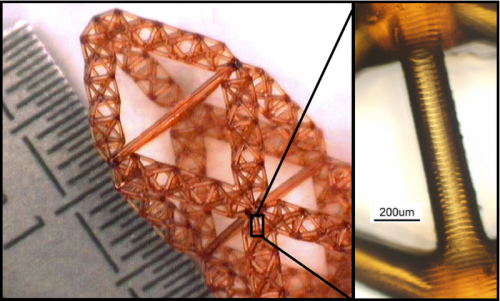December 3, 2012 report
Team uses fractal geometry to build lighter structures

(Phys.org)—A team made up of members from several European countries has published a paper in Physical Review Letters describing a technique they've developed for using fractal geometry to build structures that maintain their strength despite weighing significantly less.
The researchers began their study by noting that many structures in the world already demonstrate some degree of fractal geometry. The Eifel Tower for example, they note was essentially built using a single type of metal rod that is replicated in different sizes throughout the tower to minimize weight. What's not been the case however, they add is a predefined way to implement fractal geometry into structures in general. To rectify that, they have come up with a process that allows for creating metal beams that take advantage of fractal properties.
The first step is to create a hollow metal beam of the size desired for a given project. Next, reengineer the beam by changing its diameter and thickness such that the beam weighs as little as possible but is still able to withstand the weight or pressure it will be subjected to as a final structure. Once that is achieved, label it generation-0. The next step is to create a larger beam made out of generation-0 beams arranged using triangular subdivisions. This next beam is labeled a generation-1 beam. Generation-2 beams would be constructed by replacing all of the generation-1 beams with full scale versions of itself, only in a larger construct. Theoretically, the process can be repeated as many times as is desired or is possible, depending on scale.
The resulting structures weigh less than those made with solid steal because they contain less of it – the more generations used, the lighter the structure becomes proportionally to one made of solid steel. As an example the researchers suggest that a solar sail made with a solid metal 100 meter boom (not that anyone is proposing that) could be made to be 10,000 times lighter if a generation-3 beam were used instead.
The overall idea the team reiterates, is that it appears possible to use a standard methodology that includes fractal elements in building new structures, rather than borrowing fractal ideas and adding them in an ad hoc fashion, to achieve lighter weight constructs.
More information: Ultralight Fractal Structures from Hollow Tubes, Phys. Rev. Lett. 109, 204301 (2012) DOI: 10.1103/PhysRevLett.109.204301
Abstract
A fractal design is shown to be highly efficient both as a load bearing structure and as a general metamaterial. Through changing the hierarchical order of the structure, the scaling of material required for stability against loading can be manipulated. We show that the transition from solid to hollow beams changes the scaling in a manner analogous to increasing the hierarchical order by one. An example second order solid beam frame is constructed using rapid prototyping techniques. The optimal hierarchical order of the structure is found for different values of loading. Possible fabrication methods and applications are then discussed.
Journal information: Physical Review Letters
© 2012 Phys.org




















